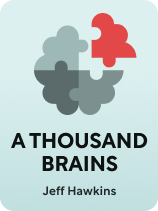

This article is an excerpt from the Shortform book guide to "A Thousand Brains" by Jeff Hawkins. Shortform has the world's best summaries and analyses of books you should be reading.
Like this article? Sign up for a free trial here.
How does your brain process abstract concepts? How does our ability to think abstractly shape our understanding of the world?
In his book A Thousand Brains, neuroscientist Jeff Hawkins seeks to explain our incredible abstract thinking ability. He proposes that our brain uses similar mechanisms for both concrete and abstract thought.
Continue reading to explore the complex mysteries of abstract thinking.
Abstract Thinking Ability
Some mental models pertain to physical spaces and objects, but how does the neocortex create and process ideas about things that we can’t see, taste, or touch? If Hawkins is correct that all your brain’s higher functions emerge from the models and predictions created by cortical columns, then the neocortex’s models and reference frames must extend beyond representations of the physical world to support our abstract thinking ability. These abstract reference frames must be more complex than those for physical objects while also functioning in much the same terms—those of creating, moving, and adjusting models of ideas in the mind.
Hawkins explains how the same basic circuitry that lets us navigate and interact with the world also underlies our capacity for language, mathematics, imagination, and conceptual reasoning. The key lies in the nature of reference frames. While reference frames for physical objects are three-dimensional, reference frames for abstract concepts have multiple dimensions, each representing a different aspect or degree of the feeling or idea. For example, emotions like happiness and sadness can be thought of as having dimensions such as intensity, duration, and type. Concepts such as human rights can be thought of as having boundaries and limits much like the contours of a physical object.
(Shortform note: Hawkins’s suggestion that we model abstract concepts in multidimensional reference frames aligns with research on the cognitive differences between people with opposing political views. Studies show that conservatives tend to focus on dimensions related to safety, stability, and authority, while liberals focus on dimensions of variety and complexity. These divergent reference frames, when applied to the same abstract concepts—such as freedom and democracy—lead to contrasting opinions on political issues. While there are other cognitive mechanisms at work, such as the power of partisan identity, understanding that people think in different reference frames might help improve understanding across political divides.)
To explain abstract thought, Hawkins proposes that, when you think about an abstract concept, your neurons fire as if you’re moving through an abstract reference frame, just as they do for models of the physical world. When you recall a memory—such as that of the house you grew up in—you mentally traverse the associated reference frame—in this case, the mental map of your old house—activating the corresponding neurons in the brain. Similarly, when you explore an abstract concept, such as the theory being presented in this book, your brain constructs a reference frame that maps out its logical connections and arguments. You then navigate this mental map as you reason through the implications of the theory.
This process of building and traversing reference frames lets you understand and manipulate abstract ideas across various domains, from cooking and music to relationships and emotions. As you create new reference frames, they connect to and build upon your existing knowledge, allowing ideas to cross-pollinate, leading to the emergence of your unique, individual patterns of thought. Thus, Hawkins concludes that the neocortex’s ability to construct and navigate multidimensional reference frames is the foundation of human intelligence and abstract reasoning.
| Embodied Cognition Hawkins’s idea that motion through reference frames (real or imagined) is essential to our capacity for abstract thought falls under an emerging scientific paradigm referred to as embodied cognition. This school of thought emphasizes the importance of the body and environment in shaping your mental processes. Proponents of this view argue that cognition isn’t just a property of the brain, but instead emerges from continuous interactions between your brain, your body, and the world. If so, then your body’s individual traits and experiences heavily influence your perceptions, your reasoning, and how you communicate them. However, critics of this theory argue that it falls short of providing satisfactory explanations for the vast majority of cognitive phenomena. They suggest that embodied cognition’s core principles are either too vague to be useful or are nonsensical when applied to most aspects of cognition. Critics say that while the body undoubtedly influences the mind in some ways, embodied cognition can’t replace traditional theories of cognition. |

———End of Preview———
Like what you just read? Read the rest of the world's best book summary and analysis of Jeff Hawkins's "A Thousand Brains" at Shortform.
Here's what you'll find in our full A Thousand Brains summary:
- Why we need updated models for brain research
- How a new theory about human intelligence could be used to advance AI research
- Why human intelligence poses a more immediate threat to the world than AI does






